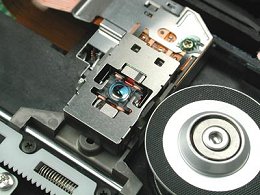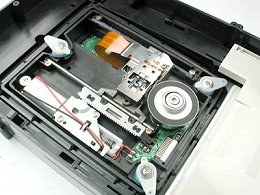How
a CD Burner Works:
The CD burner has a moving laser
assembly, just like an ordinary CD player. But in addition
to the standard "read laser," it has a "write
laser." The write laser is more powerful than the
read laser, so it interacts with the disc differently:
It alters the surface instead of just bouncing light
off it. Read lasers are not intense enough to darken
the dye material, so simply playing a CD-R in a CD drive
will not destroy any encoded information.
The laser assembly inside a CD
production system.

The write laser moves in exactly the same way as the
read laser: It moves outward while the disc spins. The
bottom plastic layer has grooves pre-pressed into it,
to guide the laser along the correct path. By calibrating
the rate of spin with the movement of the laser assembly,
the burner keeps the laser running along the track at
a constant rate of speed. To record the data, the burner
simply turns the laser writer on and off in synch with
the pattern of 1s and 0s. The laser darkens the material
to encode a 0 and leaves it translucent to encode a
1.
The machinery in a CD burner used in CD production systems
looks pretty much the same as the machinery in any CD
player. There is a mechanism that spins the disc and
another mechanism that slides the laser assembly.

Most CD burners used in production systems can create
CDs at multiple speeds. At 1x speed, the CD spins at
about the same rate as it does when the player is reading
it. This means it would take you about 60 minutes to
record 60 minutes of music. At 2x speed, it would take
you about half an hour to record 60 minutes, and so
on. For faster burning speeds, you need more advanced
laser-control systems and a faster connection between
the computer and the burner. You also need a blank disc
that is designed to record information at this speed.
The main advantage of CD-R discs
is that they work in almost all CD players and CD-ROMS,
which are among the most prevalent media players today.
In addition to this wide compatibility, CD-Rs are relatively
inexpensive.
The main drawback of the format
is that you can't reuse the discs. Once you've burned
in the digital pattern, it can't be erased and re-written.
In the mid '90s, electronics manufacturers introduced
a new CD format that addressed this problem. |



